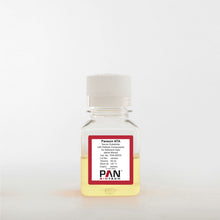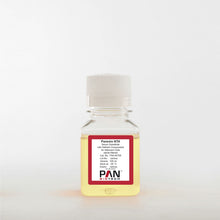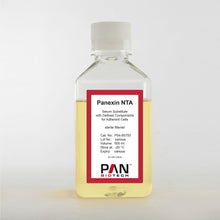Description
PAN-Biotech Panexin NTA is a ready-to-use, fully defined serum substitute for the cultivation of adherent cells under serum-free conditions. This sterile product can be used at the standard concentration of 10% in the cell culture. It supports the adherent growth of many cell types in an optimum manner.
Composition
Panexin NTA contains purified proteins (< 2% w/v), lipids, salts, amino acids, trace elements, attachment factors, hormones and traces of animal-derived components (< 2% w/v). Panexin NTA contains no growth factors, undefined hydrolysates or peptones. Customized formulations (e.g. without hormones and insulin) available on request.
Advantages
Panexin NTA is designed to replace or to reduce serum in the cell culture in a very simple manner. In most cases there is no need to change the basal medium. As Panexin NTA is fully defined and contains no peptones or hydrolysates, lot testing is no more necessary. It also allows high reproducibility and a simplified downstream process. Panexin NTA contains no growth factors and enables defined proliferation and differentiation of stem cells. Characterization studies of growth factors will obtain more reproducible and clearer results. Panexin NTA is also useful to develop sensitive cell-based in vitro tests and co-culture procedures. For cell lines which require specific growth factors these should be added in a concentration as previously used.
Suitability
Panexin NTA is suitable for the cultivation of a variety of adherent cells under serum-free culture conditions (please see figure 1) or to reduce the necessary FBS amount in cell culture.

Specifications
| Cell Type: | Various adherent cells |
|---|---|
| Culture Type: | Adherent culture |
| Liquid / Powder: | liquid |
| Product Category: | Serum Replacements |
| Size: | 50 ml, 100 ml, and 500 ml bottles |
| Sterile: | Yes |
| Storage Temperature: | -20°C, in the dark |
| Manufacturer: | PAN-Biotech GmbH |
| Country of Origin: | Germany |
Usage
This product is intended for Laboratory Research Use Only. This product may not be used as a pharmaceutical or veterinary drug, agricultural product, or food additive.
Other Names
FBS replacement, FBS substitute, serum substitute
Resources
Product References
- Nöltner, Lukas et al. “CeDaD-a novel assay for simultaneous tracking of cell death and division in a single population.” Cell death discovery vol. 11,1 86. 4 Mar. 2025, doi:10.1038/s41420-025-02370-7
- Surur, Abdrrahman Shemsu et al. “Fexinidazole optimization: enhancing anti-leishmanial profile, metabolic stability and hERG safety.” RSC medicinal chemistry, vol. 15,11 3837–3852. 30 Aug. 2024, doi:10.1039/d4md00426d
- Kohler, Robin, and Kurt Engeland. “A-MYB substitutes for B-MYB in activating cell cycle genes and in stimulating proliferation.” Nucleic acids research vol. 52,12 (2024): 6830-6849. doi:10.1093/nar/gkae370
- Wurm, Konrad W et al. “Carba Analogues of Flupirtine and Retigabine with Improved Oxidation Resistance and Reduced Risk of Quinoid Metabolite Formation.” ChemMedChem vol. 17,16 (2022): e202200262. doi:10.1002/cmdc.202200262
- Martin, Catherine Ann et al. “Adipose tissue derived stromal cells in a gelatin-based 3D matrix with exclusive ascorbic acid signalling emerged as a novel neural tissue engineering construct: an innovative prototype for soft tissue.” Regenerative biomaterials vol. 9 rbac031. 24 May. 2022, doi:10.1093/rb/rbac031
- Wurm, Konrad W et al. “Modifications of the Triaminoaryl Metabophore of Flupirtine and Retigabine Aimed at Avoiding Quinone Diimine Formation.” ACS omega vol. 7,9 7989-8012. 25 Feb. 2022, doi:10.1021/acsomega.1c07103
- Sotolongo Bellón, Junel et al. “Four-color single-molecule imaging with engineered tags resolves the molecular architecture of signaling complexes in the plasma membrane.” Cell reports methods vol. 2,2 100165. 4 Feb. 2022, doi:10.1016/j.crmeth.2022.100165
- Wanes, Dalanda et al. “Proliferation and Differentiation of Intestinal Caco-2 Cells Are Maintained in Culture with Human Platelet Lysate Instead of Fetal Calf Serum.” Cells vol. 10,11 3038. 5 Nov. 2021, doi:10.3390/cells10113038
- Kappes, Lucy et al. “Ambrisentan, an endothelin receptor type A-selective antagonist, inhibits cancer cell migration, invasion, and metastasis.” Scientific reports vol. 10,1 15931. 28 Sep. 2020, doi:10.1038/s41598-020-72960-1
- Ratschker, Teresa et al. “Mitoxantrone-Loaded Nanoparticles for Magnetically Controlled Tumor Therapy-Induction of Tumor Cell Death, Release of Danger Signals and Activation of Immune Cells.” Pharmaceutics vol. 12,10 923. 27 Sep. 2020, doi:10.3390/pharmaceutics12100923
- Ender, Fanny et al. “Detection and Quantification of Extracellular Vesicles via FACS: Membrane Labeling Matters!.” International journal of molecular sciences vol. 21,1 291. 31 Dec. 2019, doi:10.3390/ijms21010291
- Hartmann, Jessica et al. “A Library-Based Screening Strategy for the Identification of DARPins as Ligands for Receptor-Targeted AAV and Lentiviral Vectors.” Molecular therapy. Methods & clinical development vol. 10 128-143. 6 Jul. 2018, doi:10.1016/j.omtm.2018.07.001
- Kuen, Janina et al. “Pancreatic cancer cell/fibroblast co-culture induces M2 like macrophages that influence therapeutic response in a 3D model.” PloS one vol. 12,7 e0182039. 27 Jul. 2017, doi:10.1371/journal.pone.0182039
- Poller, Johanna M et al. “Selection of potential iron oxide nanoparticles for breast cancer treatment based on in vitro cytotoxicity and cellular uptake.” International journal of nanomedicine vol. 12 3207-3220. 19 Apr. 2017, doi:10.2147/IJN.S132369
- Harati, Kamran et al. “Tumor-associated fibroblasts promote the proliferation and decrease the doxorubicin sensitivity of liposarcoma cells.” International journal of molecular medicine vol. 37,6 (2016): 1535-41. doi:10.3892/ijmm.2016.2556
- Puts, Regina et al. “A Focused Low-Intensity Pulsed Ultrasound (FLIPUS) System for Cell Stimulation: Physical and Biological Proof of Principle.” IEEE transactions on ultrasonics, ferroelectrics, and frequency control vol. 63,1 (2016): 91-100. doi:10.1109/TUFFC.2015.2498042
- Majety, Meher et al. “Fibroblasts Influence Survival and Therapeutic Response in a 3D Co-Culture Model.” PloS one vol. 10,6 e0127948. 8 Jun. 2015, doi:10.1371/journal.pone.0127948
- Pajtler, Kristian W et al. “Neuroblastoma in dialog with its stroma: NTRK1 is a regulator of cellular cross-talk with Schwann cells.” Oncotarget vol. 5,22 (2014): 11180-92. doi:10.18632/oncotarget.2611
- R. Puts, T. Ambrosi, A. Kadow-Romacker, K. Raum, K. Ruschke and P. Knaus, "In-vitro stimulation of cells of the musculoskeletal system with focused Low-Intensity Pulsed Ultrasound (FLIPUS): Analyses of cellular activities in response to the optimized acoustic dose," 2014 IEEE International Ultrasonics Symposium, Chicago, IL, USA, 2014, pp. 1630-1633, doi: 10.1109/ULTSYM.2014.0404.
- Schmidt, Silvia K et al. “Influence of tryptophan contained in 1-Methyl-Tryptophan on antimicrobial and immunoregulatory functions of indoleamine 2,3-dioxygenase.” PloS one vol. 7,9 (2012): e44797. doi:10.1371/journal.pone.0044797
Related Products
- Panexin Serum Replacements
- Serum-Free Media
- Panserin 293A: Serum-free medium for HEK293 cells in adherent culture
Ilex Life Sciences LLC is an authorized distributor of PAN-Biotech GmbH.






